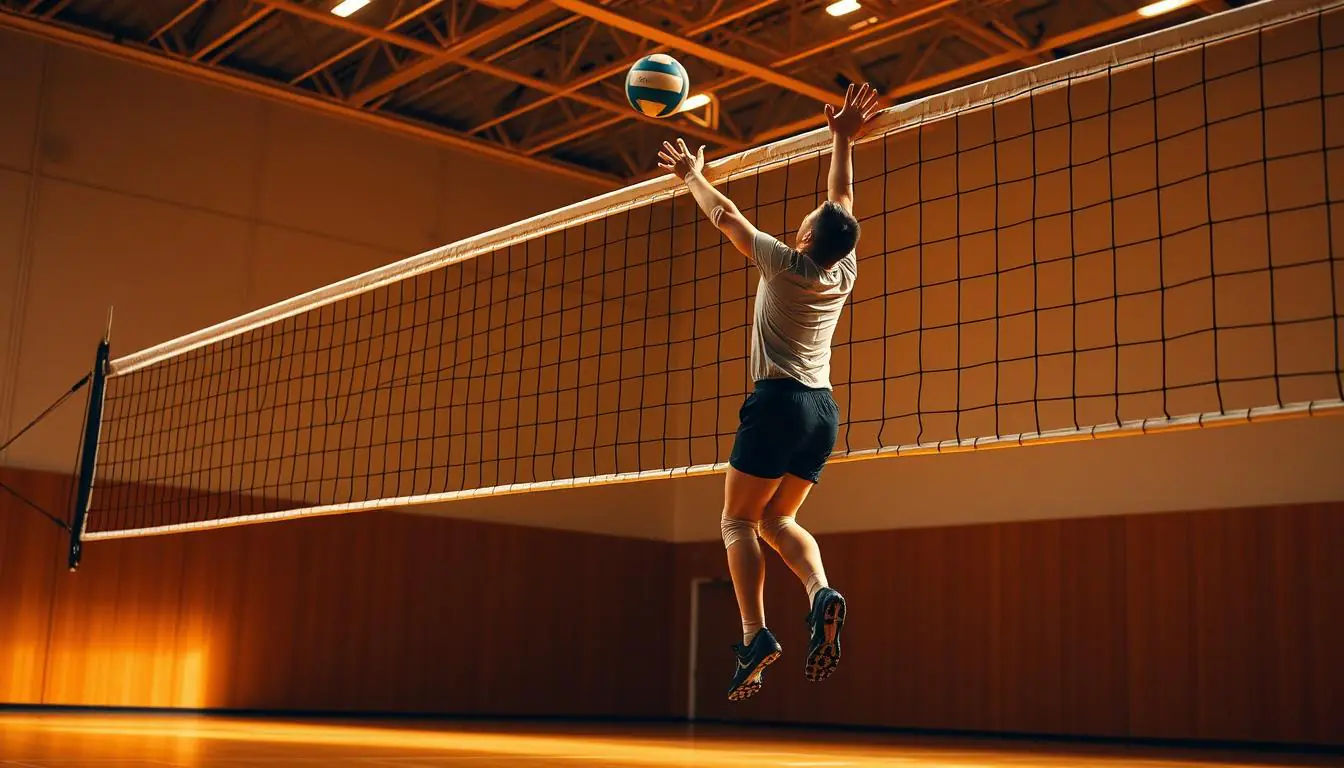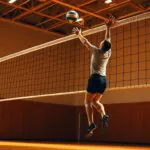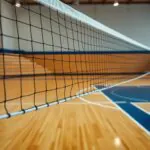When I first found out about rebound net volleyball training, my whole view on the sport changed. No more hit-or-miss practice and limited skill growth. The Elite XL Rebounder by All Ball Pro became my go-to for boosting my volleyball game.
Volleyball training is more than just repeating moves; it’s about focused practice. The rebound net opened up new possibilities, letting me practice game-like scenarios and up my skills. It helped me get better at passing and quick reflexes, becoming my top ally on the court.
What’s great about rebound net volleyball is the instant feedback it gives. Every bounce and return is a chance to learn. I soon saw that regular practice with a rebounder could really up my game, turning me from an average player to a more confident and skilled one.
Key Takeaways
- Rebound nets provide instant skill development feedback
- Training can significantly improve passing and defensive techniques
- Solo practice becomes more effective and targeted
- Develops muscle memory through repetitive, controlled drills
- Enhances overall volleyball performance with consistent use
Understanding the Power of Volleyball Rebound Training
Volleyball rebounder training has changed how players get better. As a big fan of volleyball, I’ve seen how these tools help improve skills. They do this without needing a whole team or a big setup.
Rebound nets let athletes work on many volleyball skills alone. These tools mimic game situations. This helps players get better with lots of practice.
Benefits of Using a Rebounder
A volleyball rebounder brings many benefits to your training:
- Instant feedback on technique and ball control
- Ability to practice serves, passes, and hits alone
- Builds muscle memory with repeated movements
- Boosts reaction time and hand-eye coordination
Types of Rebound Net Types
There are many rebound net types for different skill levels and needs. From easy-to-carry options to top-notch gear, there’s something for everyone:
- Portable Rebounders: Light and simple to set up
- Fixed Training Nets: Great for lots of practice
- Adjustable Tension Nets: Customizable for different training
Setting Up Your Training Space
Having the right training area is key for getting the most out of your rebounder. Look for a space big enough to move around. It should have a flat surface for consistent ball returns.
Pro tip: Set up your rebounder at different angles. This will challenge you and help you get better at various skills. It’s a great way to boost your game.
Essential Passing and Setting Drills

Improving your volleyball skills takes hard work and focused drills. I’ve learned that using a rebound net for passing drills boosts your game. These exercises improve your accuracy, quickness, and muscle memory.
- Passing Accuracy Drill: Players shuffle to the line and execute precise passes to the setter
- Russian Passing Drill: Requires two quick successive passes to enhance agility
- Serve Receive Drill: Rotational practice across different court positions
Setting techniques are also vital for your team’s success. It’s important to practice specific skills like hand positioning and body control. The Sit-up or Set-up drill is great for beginners, while the Double Vision drill is for more advanced players.
When practicing setting, focus on:
- Proper hand positioning
- Consistent body posture
- Understanding different setting tempos
- Developing muscle memory through repetition
Using a rebound net lets you practice these drills on your own. This way, you can keep improving your skills. Whether you’re new or experienced, these drills will boost your confidence and precision.
Mastering Defensive Techniques with a Rebounder
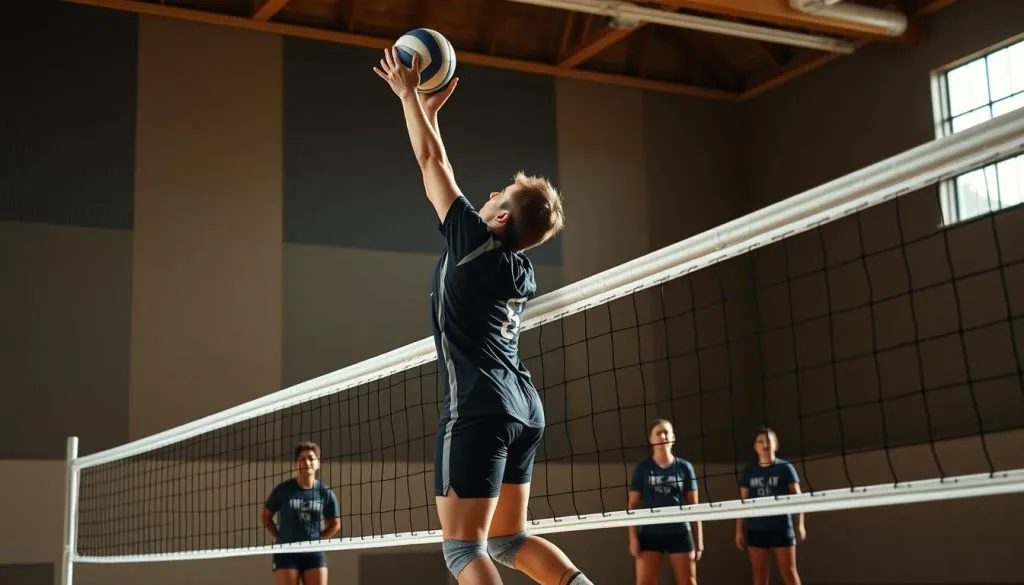
Volleyball defense needs quick reflexes and exact positioning. A rebounder makes your defensive skills better by giving you tough training. Regular use of a rebound net boosts your defensive game.
Being great at volleyball defense means mastering many skills. The right training helps players react instinctively, which is key in games.
Quick Reaction Drills
Reaction drills are key for defense. They make players better at handling sudden ball movements.
- Start with slow, predictable ball returns
- Gradually increase the speed and unpredictability of throws
- Practice catching or redirecting the ball from various angles
Footwork and Positioning Practice
Good footwork is vital for covering the court. A rebounder helps improve your side-to-side movement and positioning.
- Focus on side-to-side shuffling
- Practice quick directional changes
- Maintain a low, athletic stance
Digging Fundamentals
Digging is a key skill in volleyball defense. It needs precision and timing. The rebounder helps practice tough ball returns and perfect digging techniques.
- Practice low ball retrievals
- Work on controlling ball direction after a dig
- Develop muscle memory for different dig scenarios
Pro tip: Adjust the rebounder’s angle to create varied ball trajectories that mimic real-game situations.
Advanced Serving Practice Techniques
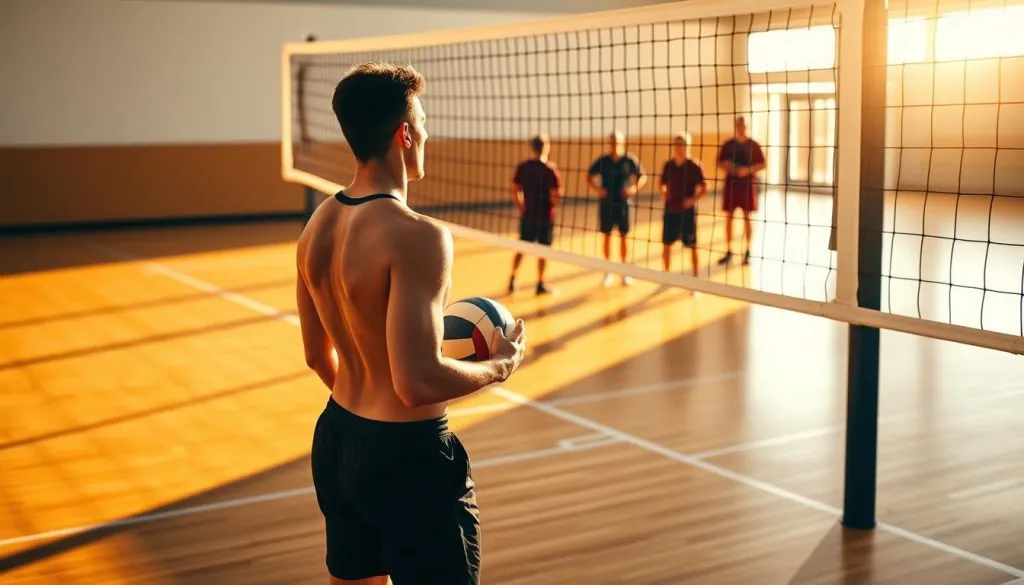
Improving serve accuracy is key for volleyball players. Using a rebound net for volleyball serving drills has changed my serving game. The net’s feedback lets me tweak my technique and get better fast.
- Target zone serving practice
- Consistent repetition of serving motions
- Analyzing spin and trajectory after each serve
Drills work best when you focus on specific skills. Break your serve into parts like:
- Proper foot positioning
- Consistent toss height
- Arm swing mechanics
- Contact point precision
The rebound net shows you how your serve looks and where it might go wrong. Practicing with goals can turn a basic serve into a strong one.
| Serve Type | Accuracy Focus | Practice Technique |
|---|---|---|
| Float Serve | Minimal rotation | Flat hand contact |
| Topspin Serve | Downward trajectory | Brushing motion on ball |
| Jump Serve | Consistent contact point | Timing and jump height control |
Mastering volleyball serving drills takes time, practice, and a keen eye for improvement.
Rebound Net Volleyball: Maximizing Solo Training Sessions
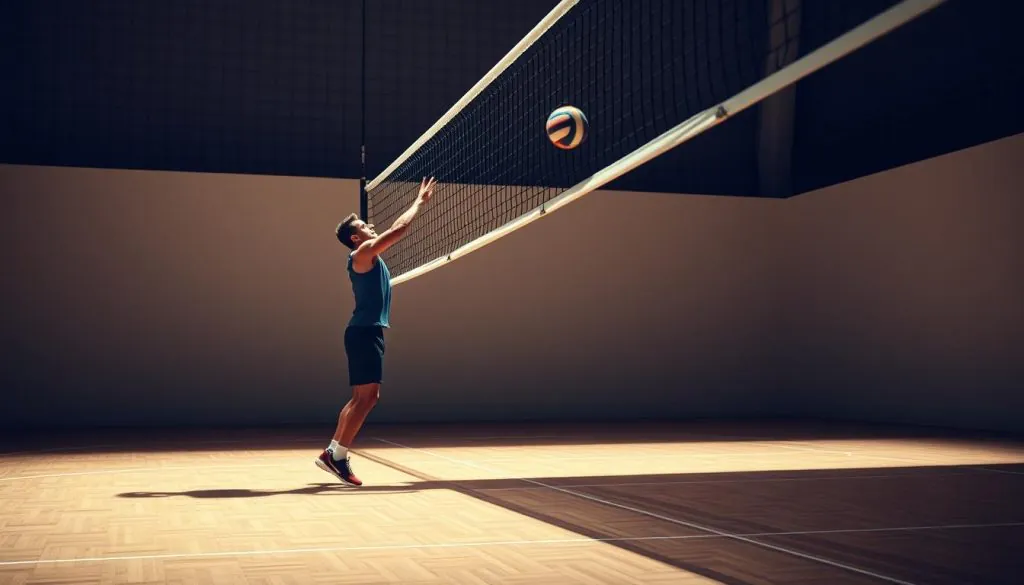
Solo volleyball training needs dedication and smart routines. A volleyball rebound net turns solo practice into a powerful tool for skill growth. I’ve found that focused training can greatly boost your skills, even without a team.
Good solo training isn’t just about doing lots of reps. It’s about structured, focused practice that pushes your skills and keeps you getting better.
Creating Practice Routines
Creating specific practice routines is key for athletes. My advice is to focus on improving certain skills:
- Arm speed drills: 15-20 reps per set
- Timing drills: 10-15 reps
- Wrist snap drill: 20 controlled hits per set
- Full spike sequence: 3 sets of 12 spikes
Progress Tracking Methods
Tracking your progress keeps you motivated and on track. I suggest keeping a detailed training log to see how you’re improving:
| Skill Area | Initial Performance | Target Performance | Improvement Method |
|---|---|---|---|
| Passing Accuracy | 60% | 85% | Consistent rebounder practice |
| Spike Consistency | 50% | 75% | Angle variation drills |
| Arm Speed | Medium | High | Repetitive hitting exercises |
Training Intensity Levels
Strategic intensity management is vital in solo volleyball training. I adjust my sessions by:
- Starting with basic techniques
- Increasing complexity gradually
- Adding challenging variations
- Keeping consistent effort
By using these strategies, athletes can turn solo training into a full skill development experience. The main thing is to stay consistent, focused, and always challenge yourself.
Partner Drills and Team Coordination
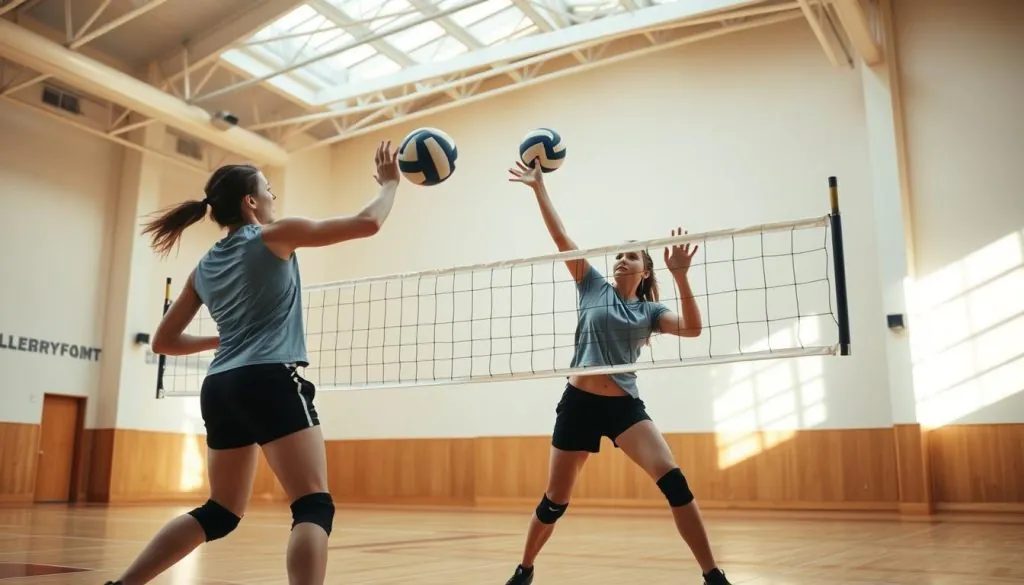
Team training turns individual skills into a strong team effort. Volleyball partner drills are key for synchronized play and clear communication. They help players trust each other, predict each other’s moves, and work together smoothly.
Our team works on specific skills in partner drills:
- Two-person passing sequences
- Communication-based defensive positioning
- Quick reaction ball exchange drills
- Coordinated serve receive practice
The 2v2 Passing Drill is a top team training strategy. It requires constant communication and ball placement responsibility. Players learn to move fast and cover different court areas.
“Successful volleyball is about understanding your teammates’ strengths and compensating for their weaknesses.” – Professional Volleyball Coach
We focus on a low, athletic stance in drills. Feet are slightly wider than shoulder-width apart. This stance helps with quick movement and better ball control. We recommend doing at least 1000 reps daily in passing, serving, and setting to build muscle memory and team unity.
Important training principles include proactive movement, early platform formation, and constant ball tracking. By practicing these, we turn individual talents into a strong team strategy.
Enhancing Blocking Skills and Net Play
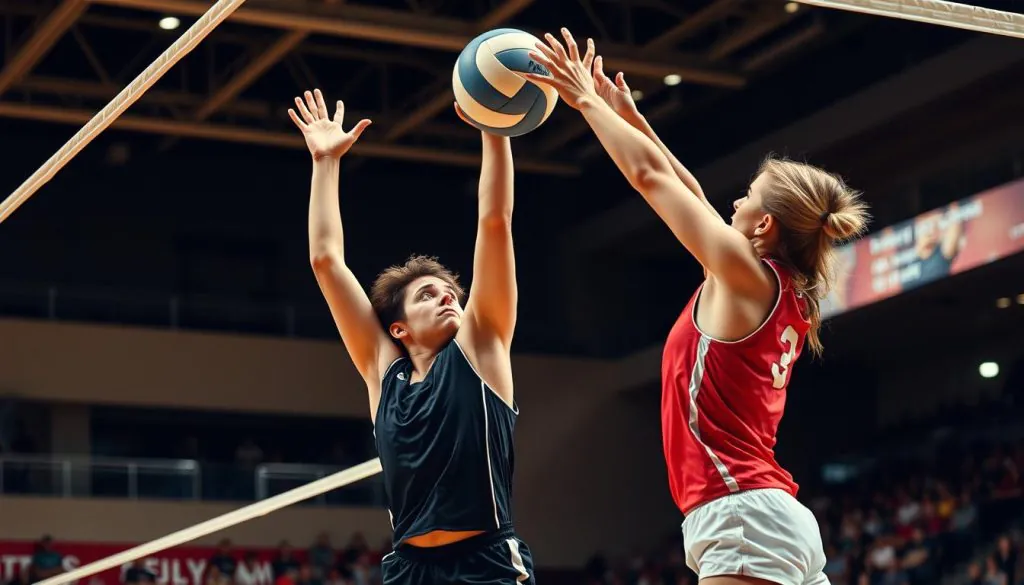
Volleyball blocking is key to winning games. It’s all about mastering net play techniques. This requires hard work and smart training.
Blocking is more than just being tall. It’s about being precise, timing your moves, and knowing the game. The right strategy can turn your defense into a strong attack.
Timing and Jump Training
Being able to jump high is essential for blocking. Here are some tips to improve your timing:
- Practice the Quick Jump Reaction Drill to get faster
- Use the Wall Press Block Drill to strengthen your hands
- Try the Speed Block Challenge to get better under pressure
Hand Positioning Exercises
How you hold your hands is important for blocking. My training includes:
- Keeping fingers spread wide
- Pointing thumbs up for better coverage
- Learning different blocking styles like swing and soft blocking
Block-to-Defense Transitions
Switching from blocking to defense smoothly is key. I suggest the Block and Transition Drill. It helps you move fast and stay alert after blocking.
Regular practice of these drills can make players strong defenders. They’ll be able to change the game with their skills.
Building Endurance Through Multi-Ball Drills
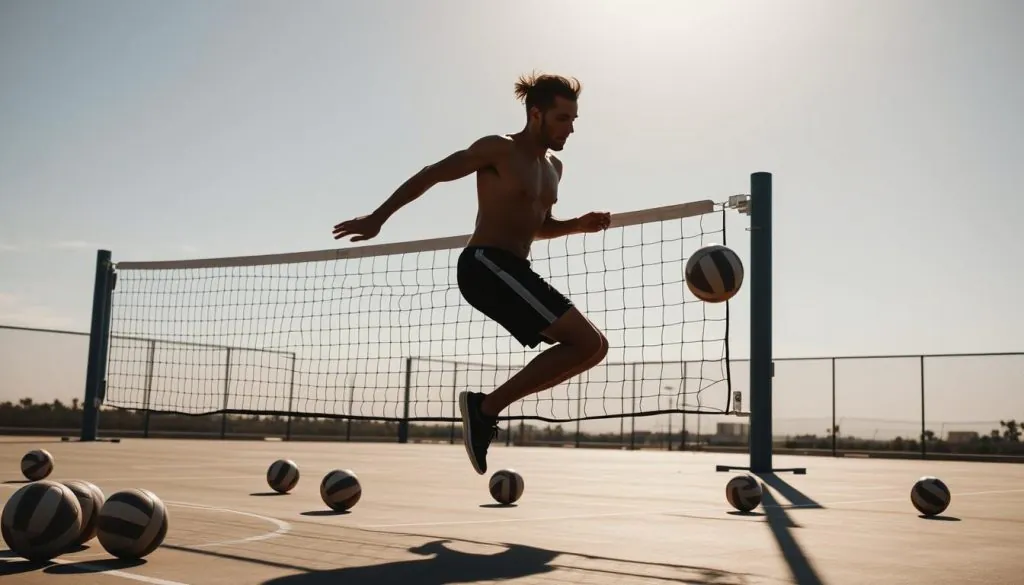
Volleyball conditioning needs smart training that tests physical limits and builds mental toughness. Multi-ball drills are my go-to for boosting endurance training. They mimic the intensity of real matches.
I focus on high-energy drills that push both body and mind. Through continuous movement, I’ve seen big gains in stamina and performance.
- Rapid repetition ball control exercises
- Continuous movement drill sequences
- High-intensity ball return practices
Using a rebound net for endurance training is super efficient. The Elite XL Rebounder lets me get continuous ball returns without a partner. This means more focused practice time.
“Consistent practice builds unbreakable athletic performance”
Strategic drill sequences are key for top-notch volleyball conditioning. I suggest focusing on:
- Three sets of 15 rapid hits
- Keeping a steady ball trajectory
- Reducing downtime between reps
By adding these multi-ball techniques, volleyball players can change their training. They’ll build amazing athletic endurance.
Conclusion
My journey with volleyball skill improvement through rebound net benefits has been life-changing. What began as a simple tool became my key to mastering techniques and boosting confidence. A rebound net lets players practice alone, honing skills like passing, setting, and spiking.
Studies back up the rebound net’s effectiveness. They show big improvements in skill when practicing with a plan. Spending 30-60 minutes a day on exercises with a rebounder can greatly improve ball-handling. The secret is regular, focused practice that challenges you to get better.
For any volleyball player, getting a good rebounder can be a big step up. It helps beginners learn the basics and advanced players fine-tune their skills. I’ve seen that with the right effort and a good rebound net, anyone can improve their game and reach their full court performance.
FAQ
What is a volleyball rebound net?
A volleyball rebound net is a tool for training. It lets players practice skills like passing and serving on their own. It gives them consistent feedback and simulates game conditions.
Can beginners use a volleyball rebound net?
Yes, beginners can use them too! Rebound nets help players of all levels. They improve skills, build muscle memory, and boost confidence through practice.
How does a rebound net help improve volleyball skills?
Rebound nets offer instant feedback and consistent ball return. They let players practice complex skills alone. This helps improve accuracy, reaction times, and muscle memory.
What types of drills can I do with a volleyball rebound net?
You can do many drills, like passing and serving. Rebound nets are versatile. They help players work on basic and advanced skills.
Do I need special equipment to use a rebound net?
Most rebound nets are easy to set up. You’ll need the net, a volleyball, and space. Some models, like the Elite XL Rebounder, are adjustable for indoor or outdoor use.
How often should I practice with a rebound net?
Practice often. Aim for 3-4 times a week, 30-60 minutes each session. This helps improve skills without getting tired.
Can team players benefit from a volleyball rebound net?
Yes! Team players can use rebound nets to get better. It’s great for off-season training or when team practice isn’t available.
What skills can I improve with a rebound net?
You can get better at passing, serving, and blocking. Rebound nets let you practice these skills over and over. This helps refine your technique.
Are rebound nets suitable for indoor and outdoor use?
Many rebound nets are made for both indoor and outdoor use. Check the manufacturer’s specs to ensure it’s right for you.
How do I choose the right rebound net for volleyball training?
Look at portability, adjustability, size, and durability. Choose one that fits your training goals. Reading reviews can help you decide.
